| Label | Label Description | Images | ||||||||||||||||||||||||||||
| S & M |
These were issued by Swarbrick & Mossman of
Glasgow. Most issues seem to be of Sandy Brown's Jazz Band, of Edinburgh
and some by Archie Semple.
The records were available from 1949 to 1952 and were limited edition
pressings (probably less that 100 of each to avoid purchase tax). Thanks to Bill Dean-Myatt for providing the label image. |
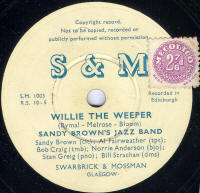 |
||||||||||||||||||||||||||||
| Sacred Melody |
These single-sided records and the labels
were reportedly made by J. F. Callander in a workshop in his garden,
where he had a hand-operated record press. He used masters formerly
belonging to British Homophone and Piccadilly records and the record
material purchased from someone who had previouslty supplied the
Douphone Unbreakable Record Co. The records, which were solely of hymns, were sold cheaply or given to charities. The pressings date from around 1935, when Calllander's activities were reported in "The Talking Machine & Wireless Trade News" (June 1935). Thanks to Bill Dean-Myatt for providing the label image. |
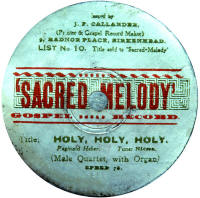 |
||||||||||||||||||||||||||||
| Sagomes |
The proprietor was Eduardo sa Gomes, a music
and photographic dealer in Trinidad. He organised the recordings, usually in New York
by American Decca,
and the records were pressed by Decca in the UK and sold in the
Caribbean. Thanks to Bill Dean-Myatt for providing the label image. |
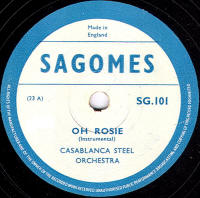 |
||||||||||||||||||||||||||||
| Saturn | These attractive picture discs were produced on behalf of ASICo (The Arts and Sciences Improvements Company). They were made out of something akin to the standard shellac, but with an image included within the upper surface. It is not known what the source of the recordings was, but the example I have here was made in England by Decca, though I have not seen anything that explains how these were manufactured. Dating them is tricky as well, but I would guess they are from the 1940s or 50s, but oddly, the run-off locked groove on mine is concentric in the manner of records from pre-1935. This implies to me that the recording is foreign, probably from a small specialist recording company. I would be grateful for any further information, or examples, preferably with images. |
|
||||||||||||||||||||||||||||
| Savana |
Savana records were
made for Rose, Morris and Company and appear to date, musically, from
1925-27. They were available in 5½", 6" & 10" sizes. The
10" use Crystalate (Imperial) masters and cost 2/- each. The others
use (Edison) Bell masters or (again) Crystalate ones. The label
designs were identical for all sizes. The 10" used a 1500 series
catalogue, the smaller ones use a 3-digit number. |
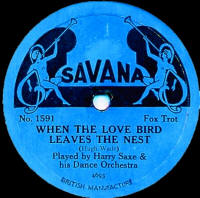 |
||||||||||||||||||||||||||||
| Savoy |
A Savoy record was announced in the
late 1920s which appears to be a flexible picture record, maybe similar to a
Goodson, with printing upon the surface, or a Trusound, with the picture
encapsulated within the material. Photographs purporting to be of
demonstrations of the flexibility of the records have been seen, but no
records have ever been reported, and it is likely they never reached the
market. In September 1949, a new Savoy record appeared, issuing modern American Jazz recordings. The records were pressed by Levy's at Aston Clinton, Bucks, and distributed by Melodisc and cost 5/9. Thanks to Bill Dean-Myatt for providing the label images of the later Savoy records.. |
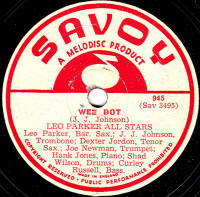  |
||||||||||||||||||||||||||||
| Scala |
Scala records first
appeared in Britain in 1912, part of the cheap German import invasion
which helped drive prices down at the time. They used mainly Beka/Lindström
masters at the time, and a catalogue series starting at 1. The exclusive
distributer was Wm. Cooper Bros, of Manchester & London. Initially they
were made in Germany, but production increasingly moved to England
following the opening of Lindström's factory in Hertford in 1913, and
the outbreak of WWI in 1914. By the end of the war, Scala had reached just over 1100. The after a short break, production passed to Crystalate, who restarted the numbering at 1200, aligning it with Coliseum, and for the next 156 issues the two labels issued the same material on the same catalogue numbers (though using different pseudonyms). Scala continued then from 360 (i.e. dropping the leading '1',) with the label design as shown, right and by now made by Vocalion. The series reached 822 by 1927, when Vocalion ceased contract 10" pressings, to concentrate on their 8" Broadcast records. |
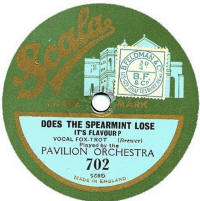 |
||||||||||||||||||||||||||||
| Scala De Luxe |
Dating to 1913 - 1915, these were originally the 12" equivalent
to the standard Scala record. The first issues used a catalogue series
DL-1 to DL-400. Subsequently these were all re-issued in a numerical
series starting, rather oddly, at 1497, running to 1579. The series
continued from 1580 using new recordings, running up to about 1664. Then
starting a new series from 5000 to 5039. It is believed that all Scala De Luxe records were made in Britain at The Mead Works, in Hertford. My thanks to Norman Field for the label scan. |
_small.jpg) |
||||||||||||||||||||||||||||
| Scala Ideal | This label was produced between 1923 and 1927 and the master pool is similar to the Grafton label (q.v.). Early issues use Federal and Emerson masters from America. Then subsequently, Pathe provided the source material. The catalogue numbers were usually in a 7000-series and there were just over 200 different records produced in the 4-year period. The records cost 1s 6d. |
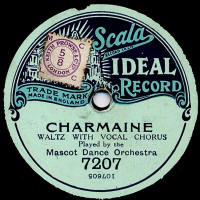 |
||||||||||||||||||||||||||||
| Scottish / Scotland's Music Week |
These two special
records, dating from 1925 & 1926 respectively, were recorded and
manufactured by Columbia
to coincide with Scotland's annual Music Week. Thanks to Bill Dean-Myatt for providing the label images. |
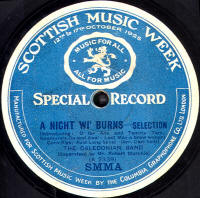 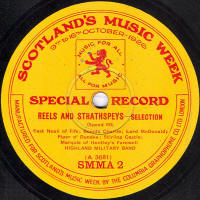 |
||||||||||||||||||||||||||||
| Scottish Records |
Dating from the
late 1940s, there were produced by Douglas Grey of Aberdeen. Thanks to Bill Dean-Myatt for providing the label image. |
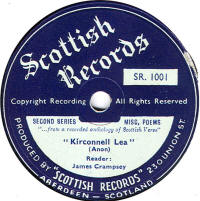 |
||||||||||||||||||||||||||||
|
SCR (Society for Cultural Relations) |
SCR (Society for
Cultural Relations between the Peoples of the British Commonwealth and
the U.S.S.R.) The society was founded in London in 1924 by leading intellectuals of the time. It still exists as the Society for Co-operation in Russian and Soviet Studies (SCRSS). The label was used on what seems to have been the society’s only venture into records which was an album, dated 1946, of “Some Recent English Poetry”. The album comprised 5 x 12” records (one of which was single-sided) of English-speaking poets reading, or having read for them, their own poems. The poets actually reading were Walter de la Mare, T.S. Eliot, Edith Sitwell, Cecil Day Lewis, Louis MacNeice and Stephen Spender and those whose poems had to be read for them were Alun Lewis, Sidney Keyes and Frank Thompson, all of whom were killed in the services during the war. in his “Commentary” on side 2 of the first disc, the compiler John Lehmann, a well-known left-leaning intellectual and writer of the time, attempts to give the poets recorded at least a pinkish tinge for an audience of Russians or British Russophiles, but where this is clearly hopeless, as in the case of Edith Sitwell for example, he evokes the memory of the suffering shared, in air-raids for instance, during the war. The Levy’s Sound Studios matrix numbers are in two groups 8768-73 and 9296-98. Thanks to Dave Mason for providing the text and label image. |
_small.jpg) |
||||||||||||||||||||||||||||
| Seeco |
A product of Vogue records, Seeco records
were available from 1954 to 1956, and the source for many of the
recordings was Seeco records inc. of New York, USA. Thanks to Bill Dean-Myatt for providing the label image. |
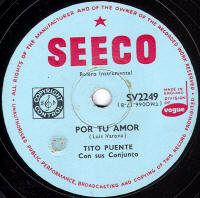 |
||||||||||||||||||||||||||||
| Sefono | Sefono was a Durium / Hit of the Week product made for sale in France. Most of these were made in the USA. However, some Sefono records state "Fabrique a Slough (Angleterre)" (Made in Slough (England)). These have a 6000-series catalogue number and an F-100 matrix. The late Hans Koert, who researched the Durium products for many years, thought these may have been also recorded in London. The music on the known issues is all French. | |||||||||||||||||||||||||||||
| Selcol |
A 6" disc, dating
from the early 1950s, produced for children. Pressed in plastic by
Selmer Plastics of Braintree, Essex, but shellac versions have also been
reported. Thanks to Bill Dean-Myatt for providing the label image. |
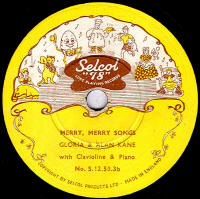 |
||||||||||||||||||||||||||||
| Selecta |
This is a series
of 5 records, made by Parlophone in the late 1920s. The records were produced for G.A. Bryen Ltd of 81, Southwark Street, London, who was the proprietor of Selecta Gramophones Ltd.
|
|
||||||||||||||||||||||||||||
| S.E.M.S. | The initials stood for La Societe de L'Edition Musique Sacree, obviously a French concern, but the records were sold in the late 1940s & early 1950s by Neglected Masterpieces Recording Co. Ltd of City Road, London. Available in 10" and 12" sizes. | |||||||||||||||||||||||||||||
| Senafone |
These were
recorded by EMI in the 1950s. The reference on the label to C.F.A.O. in
France, UK & USA is still a mystery. Thanks to Bill Dean-Myatt for providing the label image. |
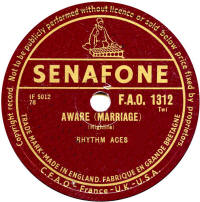 |
||||||||||||||||||||||||||||
|
Seventy-Seven (77) |
This was established in 1957 by Doug Dobell,
founder of the famous Dobell's Jazz Record shop, the address of which
was 77, Charing Cross Road, London, hence the label's name. Apart from British recordings made specially for the label, there were also American recordings issued. The first few were issued on 78rpm discs in 1958, but most were 45rpm and LP records. The last recordings were made in 1979 and the label ceased in 1984. Courtesy of 45worlds.com, I have details of just three 78rpm records on this label, which I will note below. Were there any more?
Thanks to Richard Prout for providing the label image. |
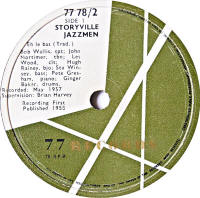 |
||||||||||||||||||||||||||||
| Shamrock |
This is an Irish
label, sold by H.P. Fay of Dublin, the records being pressed from old
"Edison Bell" masters, some of which were quite old by the times the
Shamrock records were produced, which was most likely to be the late
1920s or early 1930s. The examples seen have no catalogue numbers, and the original Edison Bell master numbers are generally, if not always, removed and replaced by Shamrock control numbers. The labels state "electrically recorded" even when, as in some cases, the recordings are old acoustic ones. |
|
||||||||||||||||||||||||||||
| Siemens |
The was a one-off record to
advertise SIemens' Opal and Pearl light bulbs. There's a certain amount
of mystery about the record, but I would assume it was given away,
probably at an exhibition. Although the record is not rare, it is
unusual to find it in it's original sleeve. The mystery is that it has a
catalogue number, which you wouldn't expect for a special issue. The
record is of the "unbreakable" format, probably made by Worldecho or
Duophone (both q.v.). The vocalist, Eddie Grossbart, when interviewed towards the end of his life, maintained that many of the musicians on the records were members of Ambrose's Orchestra and indeed, one side is composed by "Jeanette" [sic], which is believed to be the reed player Joe Jeannette, from Ambrose's Orchestra of the period. Having said that, there is also a similarity of sound to Howard Godfrey's Band as well, and Godfrey remembered recording for "Duophone". As Godfrey's band at the Waldorf Hotel was only a 5-piece unit, on record it was enlarged by other musicians, and on this occasion it could well have included a contingent of Ambrose's Orchestra. |
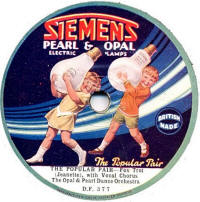 |
||||||||||||||||||||||||||||
| Silvatone |
These were 10" double-sided shellac records dating from 1934, which were
offered for being played in public without a special licence, rather
like Cinecord and Octacros. The records were advertised by Cairns &
Morrison Ltd of Percy Street, London and they costs 2/6 each. Anyone ever seen one? There were also 6" aluminium discs labelled "Silvatone Souvenir" which were also sold by Cairns & Morrison (see image). |
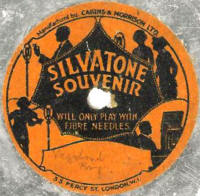 |
||||||||||||||||||||||||||||
| Silvertone |
A British-made label dating
from WWI, probably made at Lindström's Mead Works works in Hertford. The masters
are believed to mainly from Lindstrom (i.e. Beka) and Jumbo and the label carries
the patents of Odeon Records, who were part of the same group of
companies at the time. Frank Andrews tells us in "For The Record" No 51, that they were all issued as one batch in December 1916, by The Scala Record Co. but it is not known if they were produced for sale by a specific proprietor. If this is so, they were obviously over-optimistic as the catalogue numbering runs from 100 to over 500, and the records are very scarce - the listing here is petty sparse! In the early 1930s, a second Silvertone record appeared very briefly. This was an 8" record produced by British Homophone for sale in Selfridge's stores, using masters from their Plaza label. The label tells us they were specially selected by Christopher Stone. The records had a catalogue number series starting at S-1, but the series was very short-lived. In fact, I can only trace 3 records: |
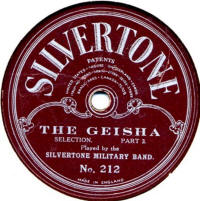 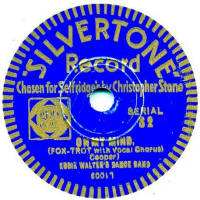 |
||||||||||||||||||||||||||||
| Silver Tone |
These were issued
by The Victory Press of Clapham Crescent, London and date from the
1950s. The repertoire is of a religious nature. Thanks to Bill Dean-Myatt for providing the label image. |
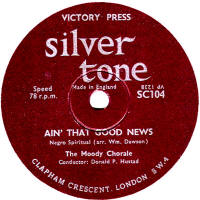 |
||||||||||||||||||||||||||||
| Simcha |
A short-lived label
available in the early 1930s, Simcha drew its masters from Piccadilly,
including some American Grey Gull items. Simcha is a Hebrew word meaning
Joy or Gladness and is pronounced "Simka" (i.e. with the -ch-
pronounced as a -k-.). The records were presumably made for a shop or
store, but I don't know which one. The main catalogue series was in a 10000-series and just over 50 were produced. In addition a Jewish series in the A-100 range was issued. |
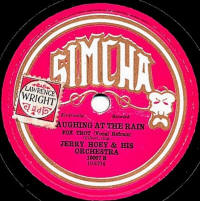 |
||||||||||||||||||||||||||||
| Singer | These were made by Decca in England for Gallo Ltd of Africa . The tunes on this record date to the mid-late 1930s so the record dates to about that time, or maybe later. |
|
||||||||||||||||||||||||||||
| Sinophone |
This label was sent into the editor of "For The Record" No. 28, from a
member in Hong Kong, but nothing more is known about it despite it being
"Made in England" according to the label. Thanks to Dr. Rainer Lotz for this image, which is a lot clearer! |
_small.jpg) |
||||||||||||||||||||||||||||
| Sirena Grand |
See
SYRENA GRAND Thanks to Bill Dean-Myatt for providing the label image. |
|
||||||||||||||||||||||||||||
| S.L.R.C. | Dating from the late 1940s, these were issued by Hume & Addison of Manchester on behalf of The South Lancs. Rhythm Club. The records show no catalogue or matrix numbers on the labels, but the matrix number "in the wax" has an SSS- prefix. |
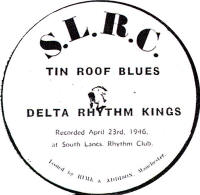 |
||||||||||||||||||||||||||||
| Smith |
A very obscure
regional label dating from the WWI period. Smith records were sold by
Herbert Smith, both at his shop at 262 Bramall Lane and at the
twice-weekly Sheaf Market. From the 1906 dealer label seen here (thanks
to Steve Walker for this), he, like many dealers at the
time, sold bicycles and gramophonalia. The label refers to phonographs,
plate machines (gramophones) and the associated records (cylinders) and
plates (disc records). He also sold own-produced bicycles under the name
"Sheffield-Langsett". Based on the solitary "Smith" record found, they were pressed in the UK by Crystalate from Grammavox (Sound Recording Company) masters and had no catalogue numbers, just using the matrix numbers to refer to each side in a similar manner to early Grammavox records. Selling his own-labelled records may have been an experiment which didn't work, judging by their scarcity. Record Details: [both sides issued on Grammavox D-47] 2087. Your Eyes Have Told Be So, sung by Glandon Lewys (bass) 2093. Beautiful Garden Of Roses, sung by Horace Mather (tenor) Please e-mail me with details of ANY of these records. |
 |
||||||||||||||||||||||||||||
| Soermus |
All of these
records are by violinist and composer Edvard Soermus (1878 - 1940), but
it is not known how many different ones were made. On the one shown here
he is accompanied at the piano by his wife, Virginia (who was British).
The records date from about 1934 and were recorded and pressed by
Crystalate for sale by Mrs Ellis of Erdington, Birmingham. The
recordings (and presumably the records) date from about 1934. Thanks to Bill Dean-Myatt for providing the label image. |
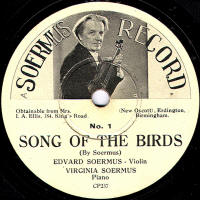 |
||||||||||||||||||||||||||||
| Solex |
British Homophone
made Solex records. They were initially an 8" disc with a very fine
groove, allowing playing time equal to a 10" disc, without getting
too near the label. Solex was BH's first 8" disc, being available
in 1930 & 1931. Catalogue numbers started logically at 1 and ran to
about 70. In 1935, BH revivied the name for a short-lived 10" disc
with a catalogue series starting at SX-101. The patent mentioned across the middle of the label refers to the strobe design around the edge of the label, which was subsequently adopted by most of the British Homophone labels. |
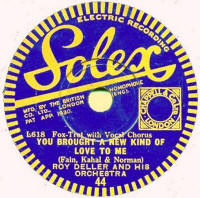 |
||||||||||||||||||||||||||||
| Solitaire |
Dating from about
1955-56, and usually pressed in vinyl, these were cover versions of current
"pop" hits and generally had two full-length popular
tunes each side, sometimes by different artists. The recordings were
from both Britain & the USA. They were distributed by Recordiscs Ltd of 23, Great Pultney Street, London W1. 10" LPs were also issued under this label. The 78s sold for 5/6, the LPs for 13/8. Thanks to Bill Dean-Myatt for providing the label image. |
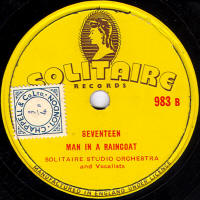 |
||||||||||||||||||||||||||||
| Songs & Laughs |
Although only a
monochrome copy of the label is available to view here, it gives the
appearance of Bulldog records of pre-1920, and indeed "The Passing Show"
dates from 1914. Thanks to Bill Dean-Myatt for providing the label image. Please e-mail me with details of ANY of these records, and a colour image would be useful too! |
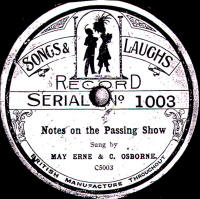 |
||||||||||||||||||||||||||||
| Sonodisc | These records date from the 1930s and were produced by Sonodisc Ltd, as language courses, similar to Linguaphone. The records were recorded & manufactured by Crystalate Ltd (as were Linguaphone at this time). After Decca took over Crystalate in 1937, Decca took on the recording side and the records were then pressed by The Linguaphone factory in Slough. Linguaphone eventually took over Sonodisc entirely in 1964. |
 |
||||||||||||||||||||||||||||
| Sound Recording Committee |
Strictly speaking, these are outside of my scope, since the
records are speed 24rpm. This company issued talking books for the
Blind. The records date from the mid-1930s and were 12" size and
manufactred by Decca. Thanks to Bill Dean-Myatt for providing the label image. |
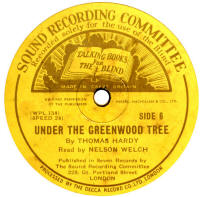 |
||||||||||||||||||||||||||||
| Soundwave |
One of the many
pre-WWI labels pressed in Germany for the British market using masters
from J. Blum & Co and possibly Polyphon.
There are two series, possibly using two difference sources for masters; the records themselves are very scarce.
|
|
||||||||||||||||||||||||||||
| Southern |
The Southern Music Publishing Company were formed in 1932, but
they didn't start having records made of their library music until 1960.
These 78s, which were published until 1969, were always pressed in
vinyl. It is not known who recorded and pressed these records. The catalogue number started at MQ-501 in 1960 and Frank Andrews reports MQ-962 in 1969. The matrix numbers are in an SMP-series which doesn't help identify the recording company as it obviously just stands for Southern Music Publishing. |
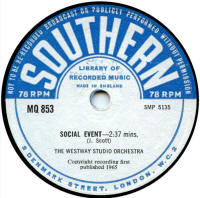 |
||||||||||||||||||||||||||||
| Sovereign |
A very short-lived
and early disc record which appeared in 1907 for a few months, Sovereign
were 10" double-sided and used Nicole masters and were manufactured
from the same "unbreakable" material as Nicoles had been, but in black
rather than brown. The labels state they were made by the British Sonogram Company. This was effectively a subsidiary of John Watson Hawd's Disc Record Company of Stockport. Hawd had purchased the machinery & masters from Nicole Freres when the company went into administration. Sovereign Records sold for 2/- each. The British Sonogram Company advertised new recordings on the Sonogram Record label, but these have never been seen, and may never have actually appeared. |
|
||||||||||||||||||||||||||||
| SPCK |
This was a record
produced for The Society For The Promotion Of Christian Knowledge. This
was an ancient society, founded in 1698. The record (probably a one-off) dates from 1953. It is not known who recorded it, but Levy's Sound Studios pressed them in vinyl. Thanks to Bill Dean-Myatt for providing the label image. |
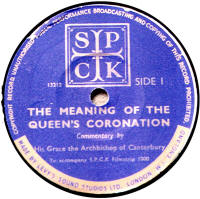 |
||||||||||||||||||||||||||||
| Special Record | There were many records labelled in this manner over the years. I will try to gather as many examples as I can and try to explain them. | |||||||||||||||||||||||||||||
| Speedway Stars |
This was a series
of 8" double-sided records of Speedway Stars who were competing in The
National Speedway League. The recordings were made by Levy's Sound Studios and the records made by Stenners of Battersea High Street, London. The discs had an SP-series catalogue number, probably starting with SP-1. Frank Andrews does not give a date for these records. The one illustrated is SP-11, with matrix numbers 11096 & 11097, by Norman Parker. I would be interested to know details of any other records in this series. Thanks to Bill Dean-Myatt for providing the label image. |
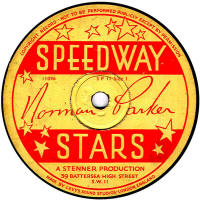 |
||||||||||||||||||||||||||||
| Standard |
A rather obscure
pre-WWI record label. In fact, there may be two labels, but I don't know
if there is any link between them. One was pressed by Edison Bell using
their "Bell" masters (seen here) and the other was a product of the Sound
Recording Company (and manufactured by Crystalate). Both companies were using 10¼" masters at the
time. The third image is of another Standard label which was pressed by Crystalate in the 1920s using masters also available on their Imperial records. Thanks to David Kent of Tasmania for the second image. Please e-mail me with details of ANY of these records. |
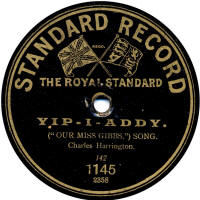 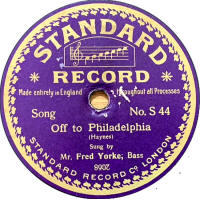 |
||||||||||||||||||||||||||||
|
Star (U.S. Import) |
The
first "Star" record sold in Britian was an American import arriving from
September 1907. It was a stencilled disc, i.e. the masters used were
from other record companies. In this case from the American Record
Company or from Columbia. Since there were no language issues, it is
assumed the Star records sold in Britian had the same label design as
the American ones, as shown here.
The original label was purple, with a white design, red titling and a five-pointed star logo. This was available in both 10" & 12" sizes record using old ARC's masters with 03000 series numbers. The catalogue numbers started at 1201 for the 10" and 5000 for the 12". Later matrix numbers in a 2000- upwards series were newly recorded masters for Hawthorne & Sheble. H&S went bankrupt in June 1909 and then Columbia took over production. Columbia's label design was black, with a gold and red design and a 6-pointed star, also available in 10" and 12" sizes. Whether the Columbia ones were imported to Britain, I don't know, but I include an image here just in case. Columbia stopped producting Star records in early 1910. They were imported by The General Phonograph Company, who had offices at 1 Worship Street, London (and also dealt in Neophone records). I have no prices, though they would probably have been relatively expensive due to the importing costs. Thanks to Bill Dean-Myatt for the first label image. |
_small.jpg) _small.jpg) |
||||||||||||||||||||||||||||
|
Star (U.K. made) |
One
of the many labels pressed by Edison Bell in the years before WWI. The
records are very scarce and Frank Andrews didn't even know about its
existence, so we can assume it was not mentioned in the British trade
press. From that, it is thought that they may have been made
for Export only, and I can only approximately date it to sometime after
1909. Catalogue numbering presumably began at 1. Only the following examples have been reported: 28: 2077 - Lively Coons (schottische) - Metropolitan Concert Orchestra / [reverse unknown] [orig issue: Bell Disc 37] 44: 2132 - On The Mississippi (Morse) - Metropolitan Orchestra [Bell 31] / 2276 - Dreams Of Ragtime (Thurban) - Metropolitan Orchestra [Bell 94] 85: 2360 - Let's All Go Down The Strand - Walter Hall / 2361 - I Used To Sigh For The Silvery Moon - Edgar Wallis. [orig issue: Bell Disc 143] Please e-mail me with details of ANY of these records. Thanks to Rainer Lotz for providing the label scan, and to John Culley for details of No. 44 |
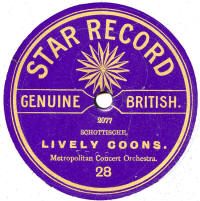 |
||||||||||||||||||||||||||||
| Stardom | These were 10" discs with gold & blue labels producted for Fidelity records, of 18, Regent Street, Weston-Super-Mare. The master numbers imply they were recorded by Oriole records (Levy's). | |||||||||||||||||||||||||||||
| The Stars | The Stars Record was a pre-WWI record made in Germany which used Polyphon masters. Sometimes the label is just a "paste-over" on existing Polyphon or 'Heraldic' records. The reference on the label to "Star artists" would seem to be a very early reference to the word "Star" meaning "celebrity". |
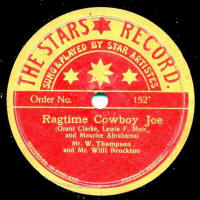 |
||||||||||||||||||||||||||||
| Stavophone |
A cheap record
(costing 1/1) produced by the Sound Recording Co in 1913 (and pressed by Crystalate). This
record was announced in the trade press at the time (along with the
first monochrome image shown here), but no records have been reported in
recent years. Because of this, it had been thought that maybe they never
actually appeared, but the second image shown here, albeit STILL from a
monchrome photo-copy, does show a needle scratch across the label,
proving the image was taken from an actual record. However, we still
don't know what the label cour was! Please e-mail me with details of ANY of these records. Also a coloured label scan. Thanks to Joe Moore for providing the first image shown here, and Bill Dean-Myatt for the second. |
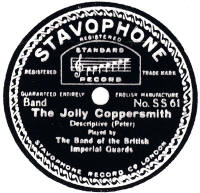 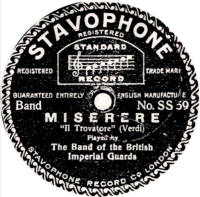 |
||||||||||||||||||||||||||||
| Stella |
Yet another pre-WWI
record produced for J. Blum & Co. Like Diploma, this one used masters
from the German Kalliope company.
judging by surviving examples, the company ran into copyright
problems as the name had alrady been registered by Pathe Freres, and it is rare to find an Stella-Gramophone Record (to give it
its full name) which hasn't been "amended". Some have the word
"Gramophone" scratched out, and other have a label printed
with "Victory" stuck over the word "Stella". The
catalogue numbers have various prefixes, such as A- and C-, followed by
a 1, 2 or 3-digit number. The label name was subsequently changed to
Victory. The second image shows what looks like an EMI product from the early 1930s, of which I know nothing more, but I am tempetd to say "made for export". Judging from the title of the piece, it may even just be a one-off, for reasons unknown. |
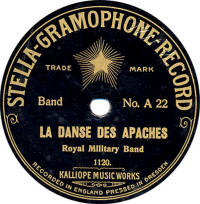 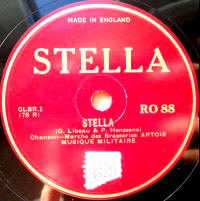 |
||||||||||||||||||||||||||||
| Sterno |
Sterno records were produced by the British
Homophone Company between 1926 and 1935, originally as a cheaper equivalent of their
Homochord label. The first Sternos are very scarce and were recorded &
produced by the Gramophone Company to a very high standard, but it is
not known who sold them. They are scarce and may have been produced for
export only. Subsequent red labelled records, introduced in 1929, were recorded by BH Co for Sterno and vary enormously in recording quality and surface noise. Almost all used British masters, and later many good dance bands recorded for Sterno, but these sold poorly. They were manufactured at the old Pathe factory in Stonebridge Park, London. The name derived from The Sterno Manufacturing Company, of which David Sternberg was the owner. He formed the British Homphone Company. |
  |
||||||||||||||||||||||||||||
| Sterno Baby |
A 6" disc
produced by the Gramophone Company for British Homophone in the mid-1920s, using the same
masters as "Homo Baby" and "Dixy". Sterno Baby is
somewhat scarcer than either, with a catalogue series in a 1000 range,
running from 1001 to 1015. The recordings are all acoustic and the dance
records are played by an orchestra and in a style more suited to playing
overtures and marches. My thanks to Dave Mason for providing the label image.
|
|
||||||||||||||||||||||||||||
| Sunbeam |
In the late 1920s there was a company called
Sunbeam Gramophone & Record Company Ltd. This company was formed in 1928
to take over Gramostyle Ltd of Camden St, Birmingham. Despite the name,
it wouid appear to be mainly a manufacturer of gramophones, but records
with this name were mentioned some years ago. In August 2023 I was sent
images of two of them. These were pressed by Duophone from their own
masters (these examples are from the D-500 series) but in normal
shellac, not the "unbreakable" material. I would be interested to hear of any further examples, other than this one (D-507) and D-501, which was the other one Roger sent me an image of. Norman Field reports that he has Sunbeam D-510.
|
 Above image courtesy of Roger Scott 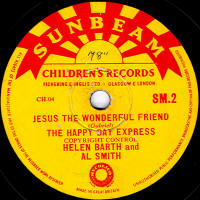 |
||||||||||||||||||||||||||||
| Sunshine |
This example is a
partial paste-over label on a Coliseum record, maybe as an attempt to
sell off obsolete stock. Thanks to Bill Dean-Myatt for providing the label image. |
_small.jpg) |
||||||||||||||||||||||||||||
| Sussex |
These were religious records made by Oriole (Levy's) for The Fred Squire International Party. Thanks to Bill Dean-Myatt for providing the label photo. |
 |
||||||||||||||||||||||||||||
| Sweet Mellow Tone |
This is a very
obscure Vocalion product from 1927. The two examples found (in the late
David Moore's collection) exactly match the Vocalion (Kildare) B-series,
Numbers B-216 & B-217. It was at this point that Vocalion decided to
stop production of 10" records to concentrate on the successful 8"
Broadcast record. There are no copyright stamps on the examples, though faintghosts of where they mau have been can be seen on a couple of the labels. This may mean they never made it on sale, or that they were designed for export to a country that didn't need copyright stamps. Unfortunately, we can't sak David where he got them, but if any more do turn up, it may give us some clues. Thanks to Charles Hippisley-Cox for providing the label image. |
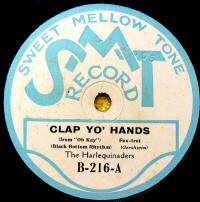 |
||||||||||||||||||||||||||||
| Swift's |
This was a 7"
double sided record recorded & manufactured by Crystalate and dating
from late 1925. Thanks to Bill Dean-Myatt for providing the label image. |
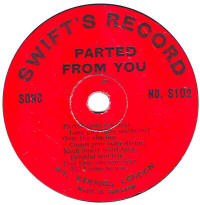 |
||||||||||||||||||||||||||||
| Sylva |
There is very little known about this record, nor about The International Sylva Talking Record Company, for whom the record was preoduced. These records were made in Germany and date from about early 1914. They slightly resemble "The Stars" record (see above) and may have used the same company to provide the masters. Thanks to Alan Williams for providing the label photo. |
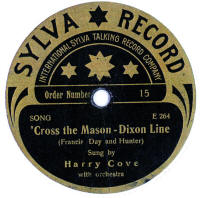 |
||||||||||||||||||||||||||||
| Synchro |
This was one of
the many Library (descriptive light music) labels that appeared in the
late 1950s and into the 1960s. Presumably Synchro were a music publisher, but not one I'm familiar with and Synchro records are not one that I've come across very often. Thanks to Bill Dean-Myatt for providing the label image. |
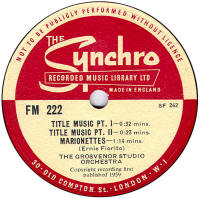 |
||||||||||||||||||||||||||||
| Syntok Film Record |
A report in "Gramophone & Radio News" in July 1929 reports that
Harry Lauder and Leslie Sarony had been recorded by this company, who
were based at 16, Garrick Street, London WC2. None of these records have been reported but it is assumed they would have been made to accompany a silent film, in the same manner as Vitaphone or British Phototone records. |
|||||||||||||||||||||||||||||
| Syrena Grand |
This was a
Russian-produced label made for Export to Britain in and around WWI.
Sometimes spelled "SIRENA" Thanks to Bill Dean-Myatt for providing the label photo. |
|